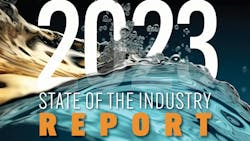Fast and furious.
No, that is not a reference to the ever-expanding movie franchise. It is how International Erosion Control Association President Jerry Sanders referred to 2023 for the stormwater and erosion control industry.
“I believe the industry is pretty much exploding,” he said. “The manufacturers and suppliers are doing lots of testing and improving on their products. They’re getting more ecologically minded, and they’re doing more intense testing, which is helping us. Then we’re having a lot of individuals now communicate back and forth and collaborate on projects.”
While there is a change of pace in testing, innovation and collaboration, not all parts of the industry were hurtling forward this year.
The results
With an industry that is ever-changing, Stormwater Solutions conducts an annual State of the Industry Survey to gauge industry attitudes and trends. This year’s results were a bit of a mixed bag, though optimism remains high. This year’s 96 survey respondents work mostly for engineering/designing and consulting companies with 28% selecting that category, followed closely by 27% in municipal government. Others work in the construction and contracting sector, county governments, distribution and sales, and state governments.
When it came to specific titles, the responses line up similarly to the company descriptions previously mentioned. The majority are engineers and technicians, coming in with 29%, and the second most common response at 20% was program manager or planner. Location wise, most respondents, 32%, live in the West, followed by 24% in the South, 19% in the Midwest, 15% live in the Northeast and 7% live internationally. When it comes to business, it seems that 2023 did not necessarily go as planned. Most respondents, 45%, said 2023 was “average.” In our 2022 State of the Industry Survey, most respondents, 45%, said they anticipated 2023 to be “good” year. When looking to 2024, 40% said they anticipate the year to be average as well.
So, while the scale seemed to shift from “good” to "average,” this perception was not so far off from the past few years. In 2020 and 2021, most survey respondents also rated those years as “average.” Last year, for our 2022 survey, 41% of respondents rated the year as “good.”
Forging ahead
Between the COVID-19 pandemic over the last few years and now inflation impacting so many industries, some companies have chosen not to keep as large of an inventory as in the past, which Sanders said can create a snowball effect and put some projects on hold.
“The sales for the industry are going to be dependent on the economy, and if things slow down, construction slows down, and I think it’s fair to say our industry is more dependent on new construction than retrofits,” Jay Holtz, chair of the government and regulatory affairs committee for SWEMA, and technical director of the Stormwater Group at Oldcastle Infrastructure, said.
Despite the somewhat unpredictability of the economy, Holtz remains optimistic for the stormwater industry. For Holtz, the National Stormwater Testing and Evaluation for Products and Practices (STEPP) initiative is a major source of optimism. In short, STEPP aims to accelerate the adoption and implementation of proprietary stormwater control measures.
“I think it shows a lot of promise for water quality and emerging pollutants,” he said.
Preparing for challenges
When asked what the greatest challenges will be in the next 24 months, survey takers could fill in their own responses. The two most expressed challenges were workforce and funding.
“I think workforce is going to be a problem, and it always is in the early spring because [there] are so many jobs kicking off,” Sanders said. “But I think those individuals who retained their leadership, their lead men and women, they’ll be able to train out, and by the middle of the year, we’ll be back on our feet running.”
Seth Brown, executive director of the National Municipal Stormwater Alliance (NMSA), said there is an expectation of generational turnover in the industry, but in addition to workforce challenges, there are also concerns over funding, as the survey results show — especially when it comes to the Infrastructure Investment and Jobs Act (IIJA).
“One of the questions I’ve heard is 'once this money goes through, then what happens? Is there going to be a drop off?’” Brown said.
Despite these questions and challenges, there is an attitude of optimism. Most survey respondents, 43%, said they would rate their organizations and companies as being in good health. Additionally, 52% said they are planning new construction within 24 months, which is a slight increase from last year, when 50% said they were planning new construction. It may tie back to Sanders’ notion of an increase in industry collaboration — by combining knowledge, projects can be implemented quickly and successfully, he said. “And that’s what I’m looking forward to this next year, is to increase that knowledge base and allow us to use the wisdom of all of our individual contractors for their individual areas as well as our specifiers and engineers,” Sanders said.

Katie Johns
Katie Johns, editor-in-chief of Stormwater Solutions, graduated from the University of Missouri in 2016 with a Bachelor of Journalism and a Bachelor of Arts in Spanish. Johns joined the Stormwater Solutions team in September 2019. Johns also helps plan the annual StormCon conference and co-hosts the Talking Under Water podcast. Prior to entering the B2B industry, she worked as a newspaper reporter and editor in Sarasota, Florida, and a magazine assistant editor in the Chicago suburbs. She can be reached at [email protected].






